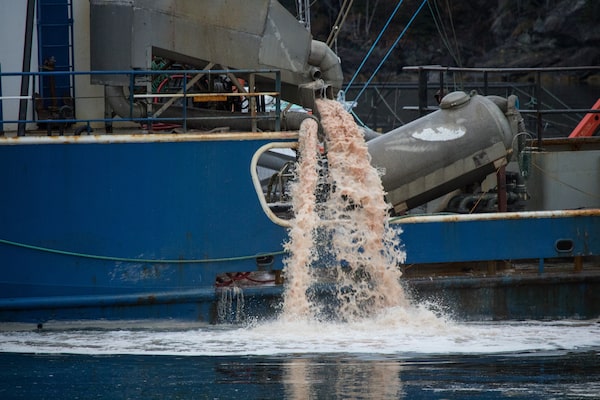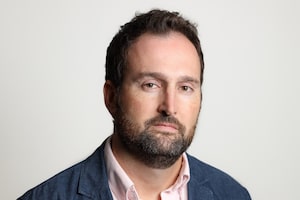
The ship Eastern Pride uses high powered vacuums to suck decomposing salmon from cage sites affected by the mass die off in Fortune Bay. The boats have been hired by the company Mowi, owners of Northern Harvest Sea Farms.Atlantic Salmon Federation/Bill Bryden/The Globe and Mail
Under their breath, the cleanup crews call it salmon butter: the pink, coagulated sludge that has taken over a remote stretch of Newfoundland’s south shore.
For weeks, workers have been processing the decomposing remains of as many as 1.8 million farmed fish that died in massive salmon cages in the middle of Fortune Bay. The die-off, which owner Northern Harvest Sea Farms blames on higher than normal water temperatures in late summer, and its messy cleanup, are inflaming the debate around the province’s growing aquaculture industry.
Fisheries unions say they’re worried about the impact on the local wild stock of millions of pounds of decomposed fish, which is being processed on land and dumped back at sea. And they argue the aquaculture industry needs to adapt to the realities of climate change if it wants to avoid similar die-offs in the future.
One of the conservationists closely watching the cleanup said the layer of rotten fish sludge sitting on the bottom of Fortune Bay was more than 15 metres thick in some areas. The weight of the dead fish was so great it pulled some of the cages underwater, allowing surviving fish to escape, he said.
“It was an absolutely awful smell,” said Don Ivany of the Atlantic Salmon Federation, who was on a boat that toured the cleanup site last week. “When the vessel went over the sludge, the propeller kind of stirred it up and the smell was so bad a couple people on the boat had a job to keep their breakfast down.”
His group and marine biologists are concerned such a large volume of rotting fish can create algae blooms that steal oxygen from the water, choking out lobster, cod and other wild species. And they want to know how the die-off was kept quiet for weeks and just how crowded the cages were, leaving the salmon more prone to stress from warming waters and fighting to breathe.
But the cleanup remains a sensitive issue in a rural part of the province where fish farming has brought jobs and investment – and in an industry Newfoundland has big plans to increase. A Northern Harvest spokesperson could not be reached for comment.
“As the rest of the world is running away from open-pen fish farming, we’re running toward it,” said Ryan Cleary, a former NDP member of Parliament who’s now president of the Federation of Independent Seafood Harvesters.
He’s calling for widespread reforms to Newfoundland’s aquaculture industry and says fish harvesters want more oversight and monitoring of the fish farms that have increasingly been popping up along the province’s coastline. But while the federal Liberal Party promises to phase out offshore, open-pen salmon farms in British Columbia, that’s not on the table in Newfoundland because of a lack of political will, Mr. Cleary said.
Others expressed concern at the sheer scale of the dumping, which has coated the shoreline of Fortune Bay with a sticky, floating residue of decomposing fish fat. One scientist called the gunk “more noxious stuff than partially treated sewage.
“We’ve never seen anything like this,” said Ian Jones, a biologist who studies marine ecology at Memorial University in St. John’s. “There’s an enormous quantity of dead fish lying rotting in the bottom of those cages. That’s not natural, that’s pollution.”
The province issued a stop-work order last week, after a diver working to clean the cages was injured. Fisheries and Oceans Canada says it’s monitoring the situation, and added that the dumping is permitted under the Fisheries Act.
“We understand the level of concern with regard to the ongoing cleanup operation, particularly with regard to the potential impacts to fish and fish habitat. We are working with the company, the province and Environment and Climate Change Canada to ensure monitoring is in place and that all reasonable measures are being taken to avoid, minimize and mitigate any potential detriments to fish and fish habitat,” spokeswoman Stella Ruddock said in an e-mail.
Jeffrey Hutchings, a marine biologist at Dalhousie University, said it’s very possible warmer-than-usual water temperatures contributed to the die-off. But it’s the combination with an “unnaturally high density” of distressed salmon in crowded cages that causes problems, he said.
“I’d say to regulators, we need to think about the sustainability of such an industry in a warming climate,” he said. “It’s natural for fish to die, but it’s not natural for this amount of fish to die and in such a small area over a short period of time.”
Keith Sullivan, president of Unifor’s Fish Food and Allied Workers Union, said regulations need to change to prevent similar problems at other fish farms. That may include imposing stricter rules around where salmon cages can be placed and lowering stocking densities, he said.
“If we want to continue growing salmon, how do we ensure this doesn’t happen again?” he said. “If temperatures are trending higher in the future, we’re concerned this won’t be an anomaly anymore.”
 Greg Mercer
Greg Mercer